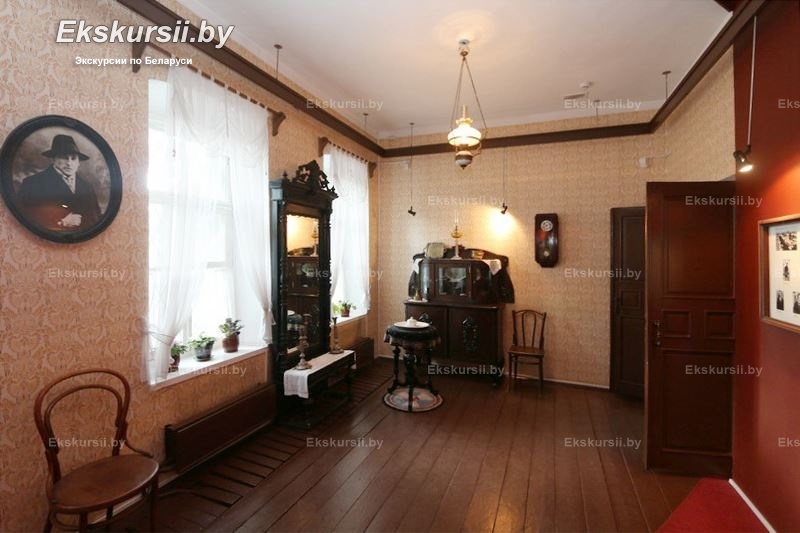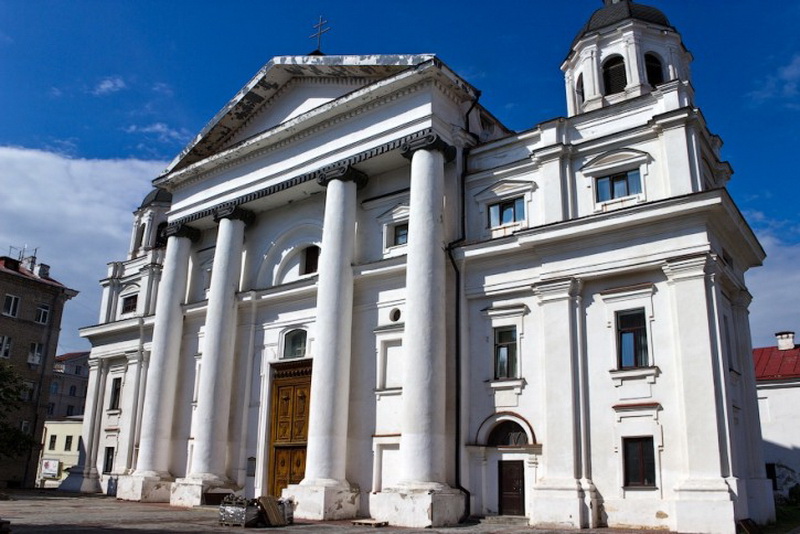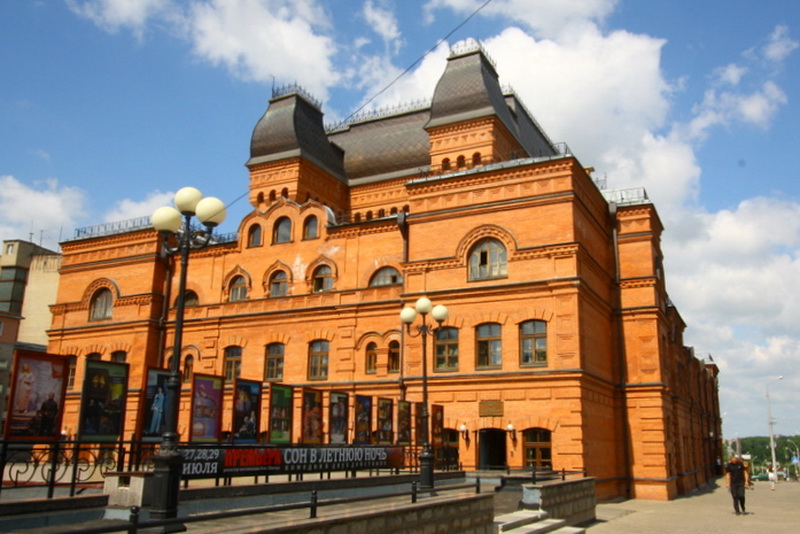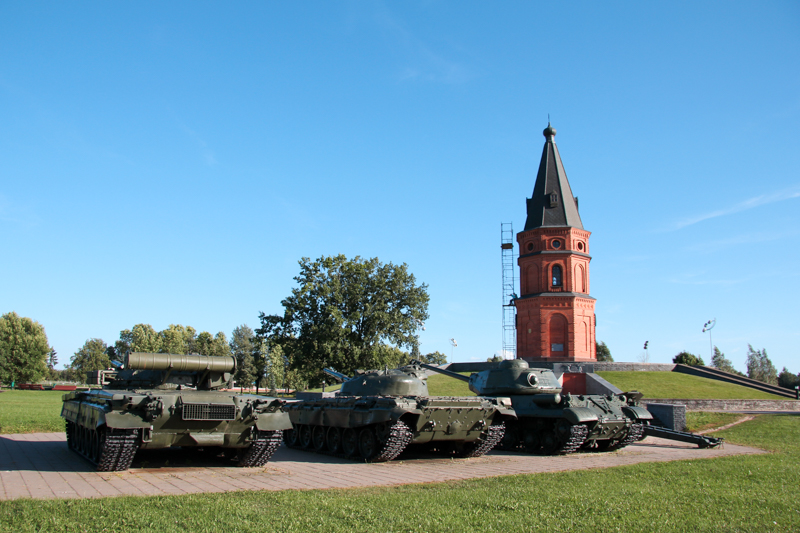Tour Vitebsk - Zdravnevo - Mogilev (2 days)
Tour description
Price
per person
70'245 ₽ for group*
от 10'035 ₽ c чел.
94'265 ₽ for group*
от 4'961 ₽ c чел.
265'982 ₽ for group*
от 5'115 ₽ c чел.
332'582 ₽ for group*
от 4'891 ₽ c чел.
The cost of excursions is approved in Belarusian rubles and when paying in other currencies the final cost may differ from the one indicated on the site depending on the exchange rate of the card issuing bank (MIR, Visa, Mastercard).
Included in the price of the excursion:
- excursions according to the program
- meeting/seeing off at the train station
- certified guide services
- transport services
Description
A two-day tour from Vitebsk to Mogilev is an exciting journey through cities rich in historical and cultural heritage, filled with an atmosphere of spirituality, art, and courage. The first day is devoted to exploring Vitebsk: a walk through the old streets will take you to the town hall, the governor's palace, the Assumption Cathedral, the Church of the Annunciation, and the Church of St. Barbara. You will see Victory Square — the largest in Belarus, see the summer amphitheater — the main stage of the “Slavianski Bazaar” festival, and immerse yourself in the world of art at the Marc Chagall Museum. The day concludes with a trip to Ilya Repin’s estate “Zdravnevo”, where inspiring landscapes preserve the spirit of the great artist.
On the second day, the route continues to Mogilev. Guests will enjoy an external tour of the Church of St. Stanislaus, the St. Nicholas Monastery, the town hall, Star Square with its unique monument to the stargazer, and the drama theater where Shalyapin and Rachmaninoff once performed. After lunch, you'll visit an ethnographic village, where you’ll discover Belarusian crafts of the 19th century, and finish the trip at Buinichi Field — the site of the heroic defense of Mogilev in 1941. The tour combines living pages of history, architectural grandeur, and the inspiration of great creators.
Excursion type
Sightseeing
Distance
340 km
Duration
2 day
Language of training
Russian
Excursion subject
Kind
Bus-Walking tours
Program
day 1
Gathering the group
Breakfast
Palace of governor

The palace of the Governor decorates Zapadnaya Dvina Embankment from the second half of the 19th century. The beautiful Palace Square became the favourite place of citizens from the moment of the emergence – it was not similar to others. Force and tranquility of the palace were in harmony with small benches along Dvina, the streaming water of the fountain and wind music reaching from the palace. And it reached often, receptions and balls were not a rarity – it becomes obvious if to remember some guests and inhabitants of the palace: шляхтич Kudinovich, brother of the empress Maria Fyodorovna duke Wurtemberg, Napoléon I, Nicholas I's brother prince Konstantin Pavlovich, writer and first Russian historical romantist Ivan Lazhechnikov. And at the beginning of the 20th century the most famous American Isadora Duncan danced here. We suggest to see the palace and to you.
Church of the Annunciation in Vitebsk

Annunciation Church – one of the oldest in Vitebsk, so, for certain, kept something unusual and unique that you and should learn. There was it in the 12th century as the embodiment of Old Russian architecture. Also the architecture of the temple which more than once is already reconstructed owing to time and events, and an original laying of "the drowned row" - used only in 2 temples of the world – in Vitebsk and in Constantinople is interesting.
Vitebsk City Hall

The Vitebsk town hall – a fine monument of architecture and an example of a combination of two refined styles: baroque and classicism. A town hall – a symbol of the city which keeps the memory of times of independence and self-government granted with the Magdebourg right. She organically fitted into ensemble of the historic center of Vitebsk which draws attention with a set unusual the embodiments of an architect thought.
Cathedral of the Assumption in Vitebsk

In the middle of the 18th century on the high Uspensky mountain that contains a minimum of 1000 of existence, monks to the baziliyena built the stone temple, on the place of former wooden. Time is ruthless – it was repeatedly destroyed and changed. Restoration of initial shape is complete recently - in 2011. And now Assumption Cathedral as if floats again over the city and the river – its domes are visible from all corners of Vitebsk, and also the ring of the biggest bell in Belarus is far heard. Only the beautiful twisting ladder connects it to the earth.
Victory Square in Vitebsk

In view of events of the II World war – there is a lot of memorial complexes devoted to it in Belarus. Vitebsk did not become an exception – here the biggest square in Belarus – Victory Square reminds of events of those years. Efforts of remarkable architects created unusual and very solemn complex which includes the composition "Three bayonets" with bas-reliefs reminding "Kurgan of Slava", the Eternal flame, 2 pools with fountains, thematic sculptures and the system of illumination which creates the special atmosphere at the Victory Square in the evening.
Church of St. Barbara in Vitebsk

Amazing church of Saint Varvara (Barbara) – one more diamond of architecture of Vitebsk which appeared here at the end of the 18th century. Use of a red brick and combination of refined styles: baroque and neoromance – create the unique image of the temple. Reserved and monumental, strict and a little mystical it attracts all eyes of passersby and definitely costs your attention.
Summer Amphitheatre

Summer Amphitheater – the main concert venue of the international festival of arts "A Slavic market in Vitebsk" since 1992. The open concert hall instantly won popularity among performers. From the first "A Slavic market" it became the main concert venue of a festival. For quarter of the century, namely it was executed to an amphitheater so much, its stage was visited practically by all famous performers of the CIS countries. The grandiose construction with the modern light and sound system developed by infrastructure is glad to both entertainment stars, and the audience, and fans of travel.
House-Museum of Marc Chagall

Vitebsk - the Homeland of the world famous artist Marc Chagall. Throughout all life of the master Vitebsk was a perennial spring of inspiration. Domes of temples and ancient small streets, tiny houses and shops with signs, tapes of wooden fences and carriers on streets forever remained on picturesque cloths, together with its well-known angels and lovers soaring in the sky … Marc Chagall's museum will open for you pages of life and works of the artist.
Lunch
Moving in Zdravnevo (21 km)
Museum-Estate of Ilya Repin «Zdravnevo»

The museum-estate «Zdravnevo» is a branch of the Vitebsk Regional Museum of Local History, the exposition of which is dedicated to the life and work of the famous Russian artist Ilya Repin.
The museum was created on the site of the manor of the painter, which he acquired in 1982 and where the paintings «Belorussian», «Autumn Bouquet», «In the Sun», «Duel», «Moonlight Night», etc. were drawn.
In the exposition: things from the use of the Repin family, furniture of the end of the XIX - beginning. XX century, Repin watercolors, drawings, icons written for the Sloboda Church, as well as original photographs, letters and books.
Moving in Vitebsk (21 km)
Transfer to the hotel. Check in
day 2
Breakfast
Check out
Moving in Mogilev (160 km)
Church of St. Stanislaus in Mogilev

In the first half of the 18th century, шляхтич Lyubuzh Zenkovich with servants attacked Mogilev – many citizens were wounded, many died. Also it hid, from the being eager revenge of crowd, in a chapel small. But to anger of people there was no limit – they pulled out a shlyakhtich from a chapel and killed. The Polish king, having learned about murder of Catholic, decided to punish citizens: "residents have to investigate all stone constructions and to construct a church in the memory of the murdered Zenkovich of this stone". – The legend says. Anyway, but the base is difficult from the most different size of stones. And the remarkable temple reached our days that is famous for one of the fullest and professional evangelical cycles of Belarus and original frescos of great art value.
Nicholas monastery with the church of St. Onufriy

Nikolsky Monastery with Onuphrius Church is one of the oldest and most beautiful Orthodox monasteries in Belarus. Located in the center of Mogilev, it attracts tourists with its historical heritage and magnificent architecture. This place will be a true discovery for those who want to explore the spiritual and cultural history of the country more deeply.
Mogilev City Hall

The Mogilev town hall – one of little remained in Belarus. She became a symbol of freedom and independence not only for residents of medieval Mogilev, but also for all subsequent generations of citizens. More than once it collapsed unfinished, but nevertheless towered over the city in 1698. Exactly here the city magistrate sat, here citizens bore "litter from a log hut", wives brought husbands that on the Gospel to give "a zarecheniye from alcoholism". The empress Catherine II, the Austrian emperor Franz Joseph II rose by the observation deck of a town hall. Here in 1917 Nicholas II abdicated. A symbol of bitterness and loss it marked itself deliberate explosion in peace time. But even after it, in 1993, what was strongly made by great-grandfathers was built up. How fate of a symbol of the city was today? We learn during the excursion.
Stars Square

The area of stars – really amazing place not only for Mogilev. It is the only monument to the astrologer in the world. It became undoubted decoration of a historical part of the city. "Astrologer" is executed on the project of the outstanding Belarusian sculptor Vladimir Zhbanov. Around it 12 chairs with zodiac signs – do not forget to sit down "on the sign" and to make the most treasured wish. And after - for a while to be transferred to Hollywood – to walk across the local Walk of Fame and will get acquainted with the most known and outstanding names of Mogilevshchina.
Mogilev Drama Theater

Thousand times N.V. Gogol was right, having written that "theater at all not a trifle at all not an empty thing if you take into account that in it the crowd can be located suddenly and that all this crowd, in anything not similar among themselves, can be shaken suddenly by one shock, begin to sob one tears and laugh one general laughter. This such department with which it is possible to tell much the world of good". So considers also all structure of the Mogilev Drama theater located in the building built for it. In the Mogilev theater Shalyapin sang, Rachmaninov played, Nicholas II applauded, Kolchak, Kalinin and Dzerzhinsky reviewed the troops. We recommend to learn more about it and to you.
Lunch
Ethnovillage Mogilev

The Belarusian ethnographic village of the 19th century is a beautiful and well-groomed territory, the city of masters, refined design, paved paths, exotic trees and flowers. This place where you will get acquainted with crafts and life of mestechkovets of the 19th century. You learn how for only a few seconds to turn a piece of clay into the work of art how to force threw also a tree to take a bizzare shape, work of masters of an embroidery and what true value "вышыванак" is how laborious. You can buy production of masters for memory.
Bujnichi field

The Buynichsky field - his writer Konstantin Simonov described in the novel "Live and Dead". There passed the first line of the Soviet defense. Through Mogilev the group of the German army "Centre" went to Moscow, planning to organize the transit point in Mogilev. Long 2 weeks many times the conceding defenders of the city resisted enemies, considerably having changed the war course. The German troops in fear were silent about defeat, having told that the city is occupied long ago. Later Mogilev will be called "the father of Stalingrad". And the war correspondent who was here, then, and later the famous writer Simonov bequeaths to dispel here the ashes. Today on the place of tank battles the memorial keeping memory of military years is created.
Transfer to the railway station
The end of the tour
Route map
Choose where to continue
Ekskursii.by
Google Chrome